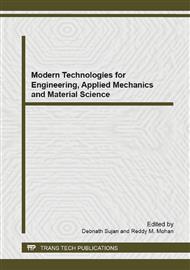p.3
p.8
p.13
p.18
p.23
p.28
p.33
p.41
Performance Evaluations of Carbon/Glass Hybrid Polymer Composites
Abstract:
In this work, the influence of hybrid effect on carbon and glass fiber reinforced polymer (FRP) on the mechanical performance for structural application was studied. The hybrid fiber reinforced polymer (FRP) composites made from woven E-glass and carbon fibers with epoxy resin. The FRP hybrid composites were fabricated using vacuum-assisted resin transfer moulding process, which is capable of producing constant thickness with high volume fractions of composite panels compared to that of traditional wet hand lay-up method. Mechanical performance of the FRP hybrid composites were evaluated against full carbon or glass fiber reinforced polymer composites. Important properties such as tensile strength, flexural strength and volume fraction of reinforcement were determined according to the ASTM standards. It was found that the mechanical properties of carbon-glass hybrid composites exhibited significant improvement in term of strength and strain respectively compared to that of full glass FRP composites and full carbon FRP composites.
Info:
Periodical:
Pages:
8-12
Citation:
Online since:
June 2014
Authors:
Price:
Сopyright:
© 2014 Trans Tech Publications Ltd. All Rights Reserved
Share:
Citation:


